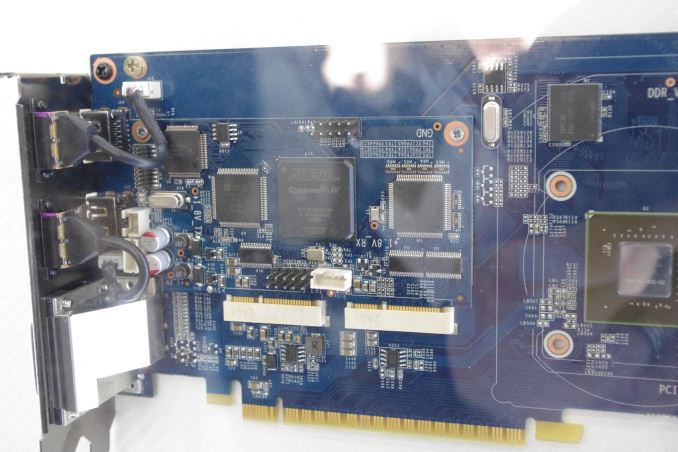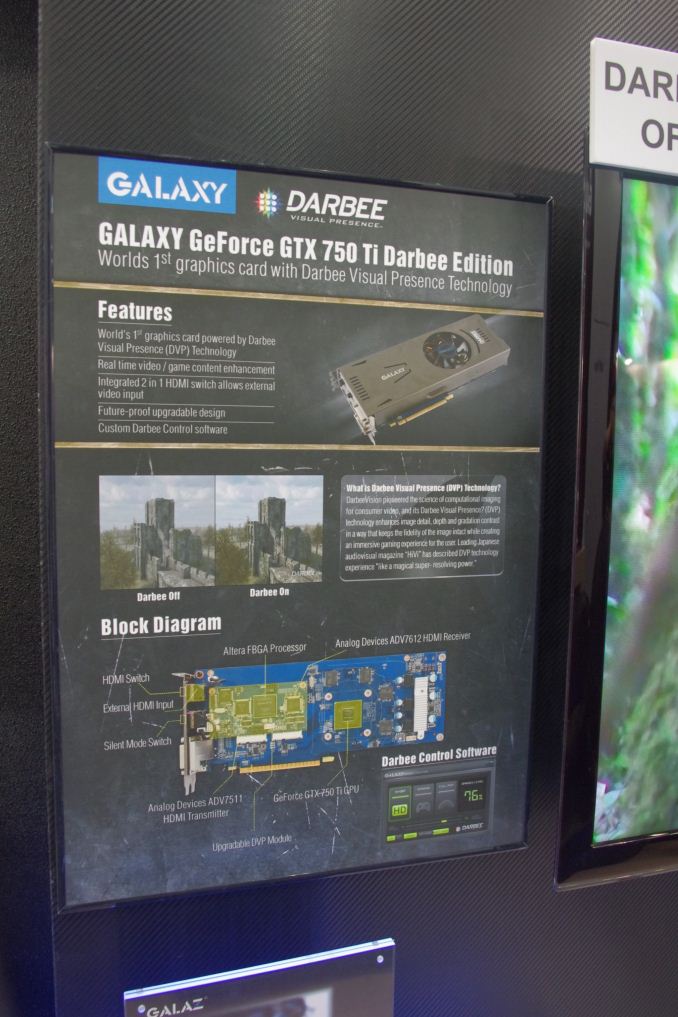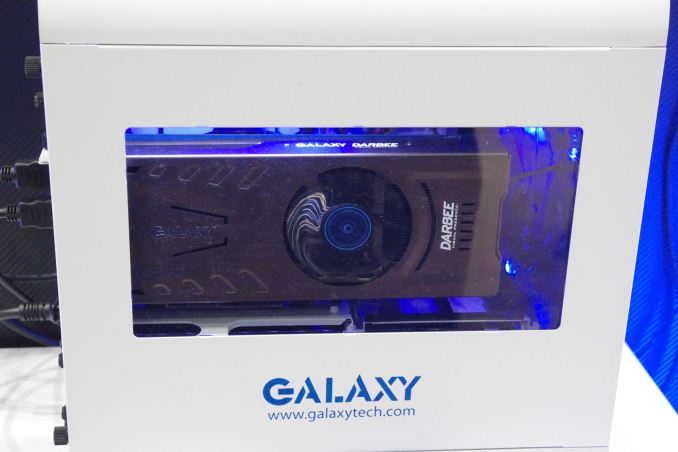Computex 2014: Galaxy Showcases GTX 750 Ti Darbee Edition
by Ian Cutress on June 5, 2014 9:15 PM EST- Posted in
- GPUs
- Galaxy
- GTX 750 Ti
- Darbee

In the realm of photo and film-editing, post processing can make the difference between bad looking media and something epic. The depth of post processing on an image or a video is usually dictated by the level of expertise of the editor or the budget, which might suggest that things could be better. Darbee is a known company that deals in media post-processing in real-time, whereby I have a couple of friends who swear by their custom boxes that use clever manipulation techniques (based on blur-and-subtract algorithms) to bring their home media system to life. What Galaxy has done is combine one of their GPU designs, the GTX 750 Ti, with a Darbee IP, to allow an all-in-one image enhanced graphics card.
The system takes a standard reference design GTX 750 Ti, extends the length, and uses an add-in card containing an Altera Cyclone IV FPGA as well as some other ICs.
The effect is output only on one HDMI port due to the hardware limitations, but users can adjust the depth of the effect from 0% (none) to 100% (full) with the included software. At current the GPU is not equipped for SLI over cabling, however I requested an edition to come to the US, allowing users to hook up three cards and run them all in SLI with the effect on three HDMI panels.
After speaking to a few friends about the technology, an interesting point came to pass. AMD and NVIDIA are currently in a battle for performance. It would not take much for one of these to invest into the Darbee post-processing ecosystem and incorporate it into their technology, thus giving an improved feature set to the brand. However, it was also mentioned how much effect Darbee has on a calibrated display. We now have a contact for Galaxy, so I will see if Ryan has time to look at a sample.
















26 Comments
View All Comments
edzieba - Friday, June 6, 2014 - link
Oppo add it because people will pay for it. Note that even the highest end TVs ship in 'showroom mode' with massive oversaturation and contrast pushed up to 11. We all know that it looks dire, but it still happens. Hell, just look at how many HD devices ship with overscan on!You're not going to magic information from nowhere. You can add a sharpening filter to the Luma channel and add a nice chroma blur (or even upsample and interpolate chroma if you have 4:2:0), but none of that requires a dedicated $300 box to do, and none of it will provide any extra visual information.
It's a darn sight better than catering to the oversharpening crowd by adding the filter to the disc through!
Wolfpup - Friday, June 6, 2014 - link
Yeah, I'm confused by this...like why would we want it? In my experience any kind of post processing effect is usually bad, save for deinterlacing...Well, okay, some of Nvidia's video settings are great to punch up a picture for better contrast, particularly on a TN panel, but this doesn't seem like something I'd need or want...
Gauner - Friday, June 6, 2014 - link
I haven't seen any footage of Darbee in action but just by searching for a few captures in google it does seem to use a unsharp masking filter with something to mitigate the amount of noise introduced back to the image, maybe some edge detection too to prevent/minimize the halos.Not trying to bash here but it seems to me like you could replicate most if not all of the effect in software using avisynth inside ffdshow in real time.
ShieTar - Friday, June 6, 2014 - link
Whatever they implement, it is clear that a high power CPU/GPU can also perform the same task, and very likely in real time. The point of having a dedicated FPGA is doing it with a good energy efficiency. That would also explain why they launch this concept with a 750Ti, and not with some high-end GPU.A5 - Friday, June 6, 2014 - link
FPGAs are a lot of things, but "power efficient" isn't usually one of them.Gauner - Friday, June 6, 2014 - link
Dunno about ShieTar.Let's say this addon costs 100$ extra and does all decoding and postprocesing with 10w, now compare it to doing it with the CPU taking 100w(I can decode video and add a fair amount of postprocesing on my old q6600 and that's slower than the slowest i3 on the market), at 12c kWh it would take over 8300 hours for the dedicated solution to start being cost effective, if the average movie is 90 minutes long that would mean over 5500 movies.
Watching two movies per day it would take longer than the useful lifespan of the system for the FPGA addon to actually save money(unless I messed up the math really bad).
I see how this can be worth the money if you like the results and don't want(or can't) to try to replicate them with software but the energy savings angle doesn't convince me.
ShieTar - Saturday, June 7, 2014 - link
Your mistake, if I may call it that, is to translate "energy saving" to "money saving". For me, it translates to "less noise", making this card more of a media player / home theater option than a high-end card, or your Q6600, would be.Also, in countries with a less subsidized power industry, electricity costs up to 35c/kWh.
Dug - Friday, June 6, 2014 - link
You can but the setup and reliability of the software when all connected together is a major headache.After 10 years of trying every post processing software out there, the Darbee is by far a better solution. This isn't an all or nothing solution either, you can adjust the amount you would like.
The only thing I would wish for is an hdmi in so you could route other devices through it.
Sancus - Friday, June 6, 2014 - link
Artificially added "clarity" is NOT clarity, no matter how good the algorithm looks in typical examples. Many people prefer oversaturated colors to accurate colors, and would say they look better, even when presented with accurate color. Does that make oversaturated video "improved" over color-accurate video?All Darbee does is produce an image alteration that some people subjectively think looks better. That's not an image improvement. It does not improve clarity, because you are not seeing what the source presents better, in any way, you are just introducing differences that were never there to begin with.
Shadowmaster625 - Friday, June 6, 2014 - link
If I had this card would my SVP still work?